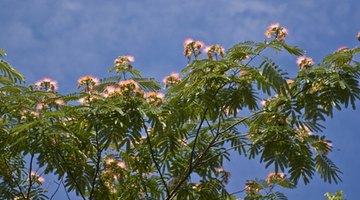Uses for Mimosa Wood
Mimosa, or Mimosa tenuiflora, is a perennial tree native to South and Central America. The leaves are fernlike and the flowers are spiky and white or pink. Mimosa trees produce seed pods that resemble pea pods.

The mimosa is considered a weed in some regions, but does have several uses in the medicinal, farming and construction arenas.
Medicinal
Native American populations of South and Central America have been using Mimosa wood as a medicine for generations. Modern medicine accepts Mimosa as a treatment for burns, leg ulcers in diabetics, skin inflammation and eczema. According to Kurt Hostettmann, M. P. Gupta and Andrew Marston, the high tannin level in the bark, along with vegetable fibers and starches in the wood, decrease pain in burn victims and increase regeneration of the skin. Mimosa wood is helpful in all general wound healing. An infusion of the leaves and bark also soothes tooth pain and mouth inflammation.
Farming
According to an agricultural study conducted by the Universidade Federal de Campina Grande in Brazil, Mimosa wood is useful as fodder and roughage for domesticated herbivores during droughts or famines. The plant can be added to food for cows, goats and sheep. The Mimosa roots fix nitrogen in the soil, improving the soil quality and acting as a natural fertilizer for the surrounding area. The high tannin level in the bark produces a useful dye or leather tanner.
Other Uses
The high tannin content of Mimosa wood prevents rot from setting in, so the wood is often used for fence posts. It is also used in making bridges, wheels and furniture. In North America, the Mimosa tree is largely ornamental. The high tannin levels protect the tree from microorganisms and pest infestation, and infusions made from the wood are used as pest repellents.
References
Writer Bio
Based in Richmond, Va., Dawn Gibbs writes about topics such as history, fashion, literature, crafts, alternative medicine and healthy living. Her work has appeared on GreenDaily.com and several style websites. Gibbs holds a Bachelor of Arts in history from Virginia Commonwealth University.
Photo Credits
- Mimosa Tree with blooms image by Photoeyes from Fotolia.com
- Mimosa Tree with blooms image by Photoeyes from Fotolia.com
More Articles



